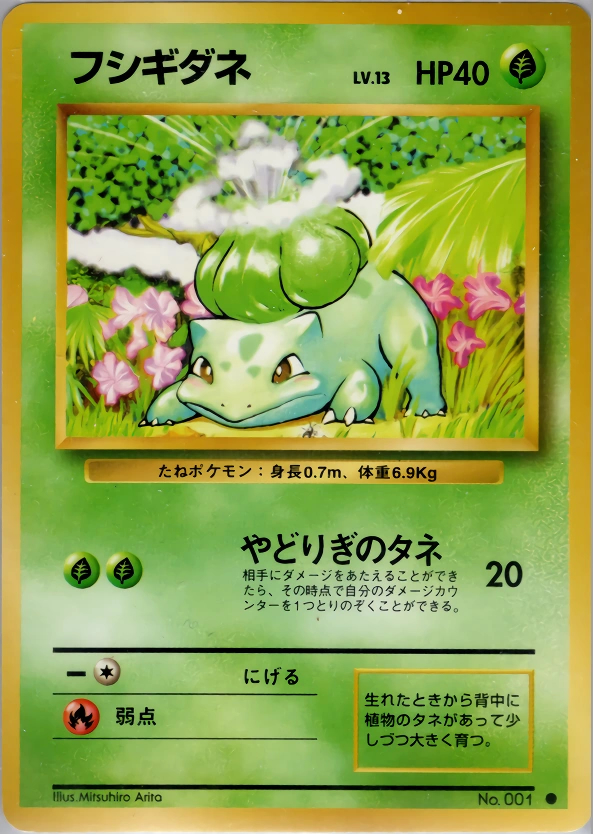The 1996 Bulbasaur card, illustrated by Mitsuhiro Arita, marked the true beginning of Pokemon’s visual universe. Before Charizard’s flames or Pikachu’s sparks, there was life, green, calm, and quietly powerful. It was the moment when the Pokemon Trading Card Game (TCG) found its artistic soul.
The first breath of Pokemon TCG art
The Bulbasaur Base Set card (1996) isn’t rare in the traditional sense, but it’s one of the most important artworks in Pokemon history. Arita captured something that would define the TCG for decades: a world that felt alive.
The scene is deceptively simple, Bulbasaur under soft sunlight, surrounded by lush greenery. But this is more than illustration. It’s environmental storytelling: an invitation into a natural world where even a single leaf tells a story.
In that era, most trading card games leaned on aggressive or exaggerated art styles. Pokemon, through Arita’s lens, chose warmth over chaos, serenity over spectacle. This approach changed how collectors and players experienced cards forever.

Mitsuhiro Arita — The painter of beginnings
Arita’s name is synonymous with Pokemon art itself. From Bulbasaur, Squirtle, and Charmander, to the now-mythic Base Set Charizard, Arita created the tone and visual identity of the Pokemon TCG. His early work was crafted using analog techniques, hand-painted with watercolor and airbrush, before being digitally adapted for printing.
The 1996 Bulbasaur Lv.13 (#44/102) embodies that craftsmanship. Every texture, every brush stroke serves a purpose. You can almost feel the humidity of the forest air, the soft light diffused through the canopy.
“I wanted the Pokemon to feel like a living creature, not just a character,” Arita once explained in an interview.
“If you could believe that Bulbasaur could exist in nature, then the card succeeded.”
That philosophy became the foundation for all future TCG artwork, bridging fantasy and reality in a way that no other card game of the time had achieved.
The emotional power of simplicityWhile later generations of cards would explore full-art foils, gold borders, and dramatic EX and GX designs, the original Bulbasaur card stands out for its restraint. It doesn’t need spectacle to feel magical. Its value lies in emotional resonance, the connection it sparks in anyone who started collecting during those early days.
Collectors often describe it as “the first card that felt real”. Not because of rarity or price, but because of the feeling it evokes: nostalgia for discovery.
That emotional connection is the foundation of Pokemon’s enduring power, the reason people still grade, frame, and display these cards nearly 30 years later.
Displaying the roots of an era
For collectors, the 1996 Bulbasaur isn’t just a card, it’s a time capsule. Its hand-painted tones and environmental composition make it a perfect piece for display.
At Foil Tavern, we see early TCG art as more than collectibles; they’re small works of cultural history. Placing a 1996 Bulbasaur in a handcrafted HexCase display transforms it from nostalgia into art, a living connection between the analog past and the premium design of today’s collector displays.
Whether it’s wall-mounted or resting on your desk stand, the HexCase reframes the story: this isn’t a common card, it’s a relic of imagination.
The collector’s reflection
In today’s market, graded Bulbasaur Base Set cards (PSA 9–10) aren’t the most expensive, but they hold immense emotional value. Collectors often choose to showcase them alongside Charizard and Pikachu, not for symmetry, but for story.
It represents the beginning, the seed that allowed everything else to grow. And like all beginnings, it deserves light.
So, while Charizard may dominate auctions and Pikachu headlines, Bulbasaur remains the quiet cornerstone of the original era, the card that whispered instead of roared.
Before the flame, there was life
Bulbasaur was the calm before the storm, the first piece of harmony in a universe that would explode with color and competition. It’s the embodiment of balance, growth, and potential, values that still inspire the artistry behind Pokemon cards today.
In the same way, our collector displays at Foil Tavern are built around that philosophy: balance between form and function, warmth and protection, nostalgia and innovation.
Because art, like nature, deserves to be seen, not hidden.
Final note
Some cards shine because they’re rare. Others because they remind us where we started.
The 1996 Bulbasaur by Mitsuhiro Arita is both.
Discover how we honor that spirit through HexCase handcrafted displays, crafted with the same attention to light, reflection, and presence that made Arita’s world bloom.
💭 Which of the original starters would you display in your HexCase?
🔗 Explore handcrafted displays at Foil Tavern where nostalgia becomes design.

